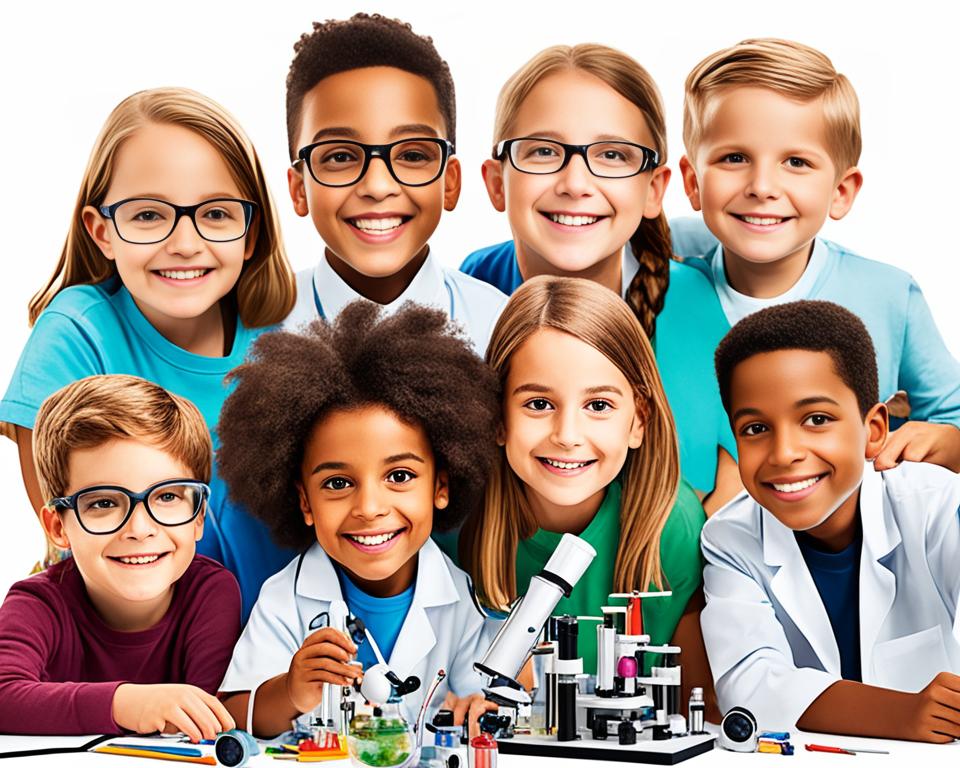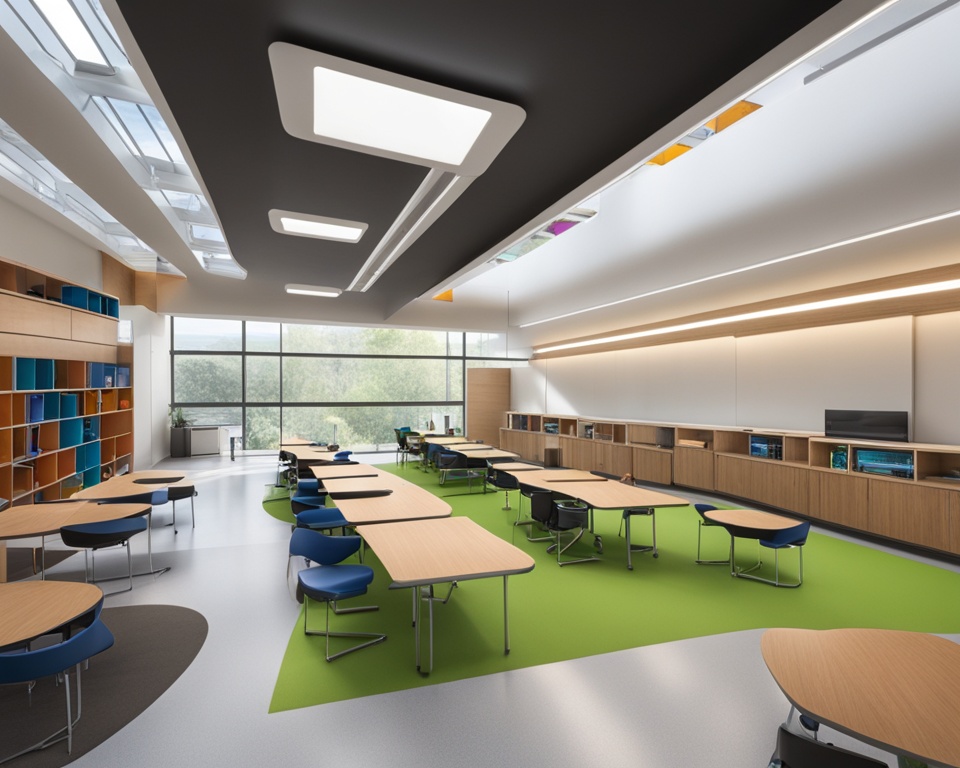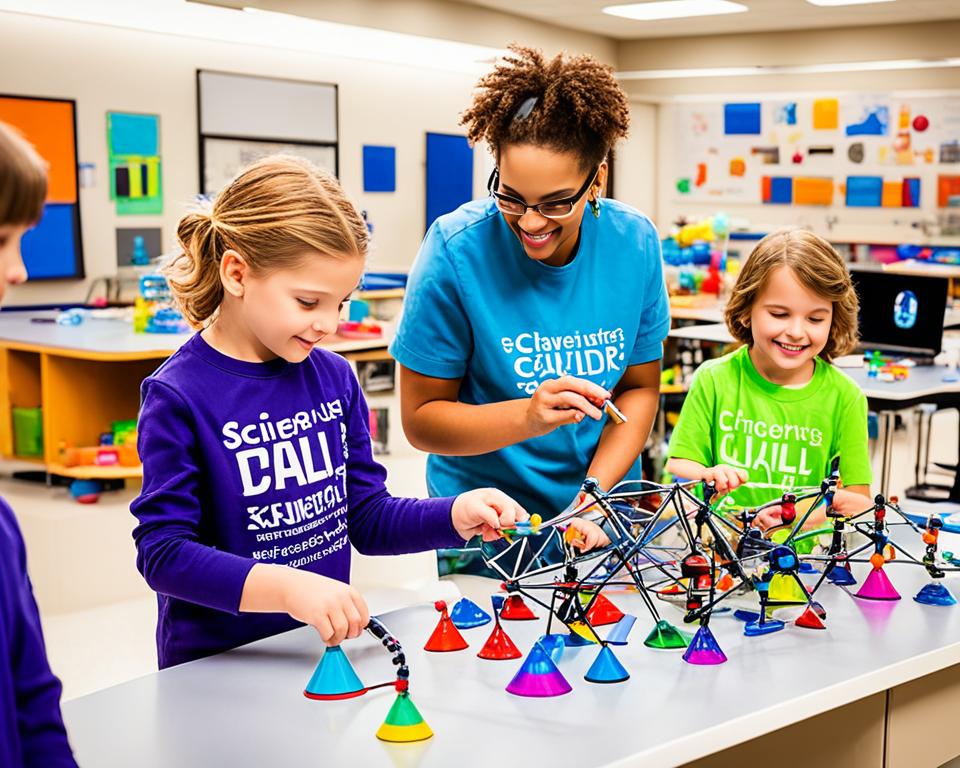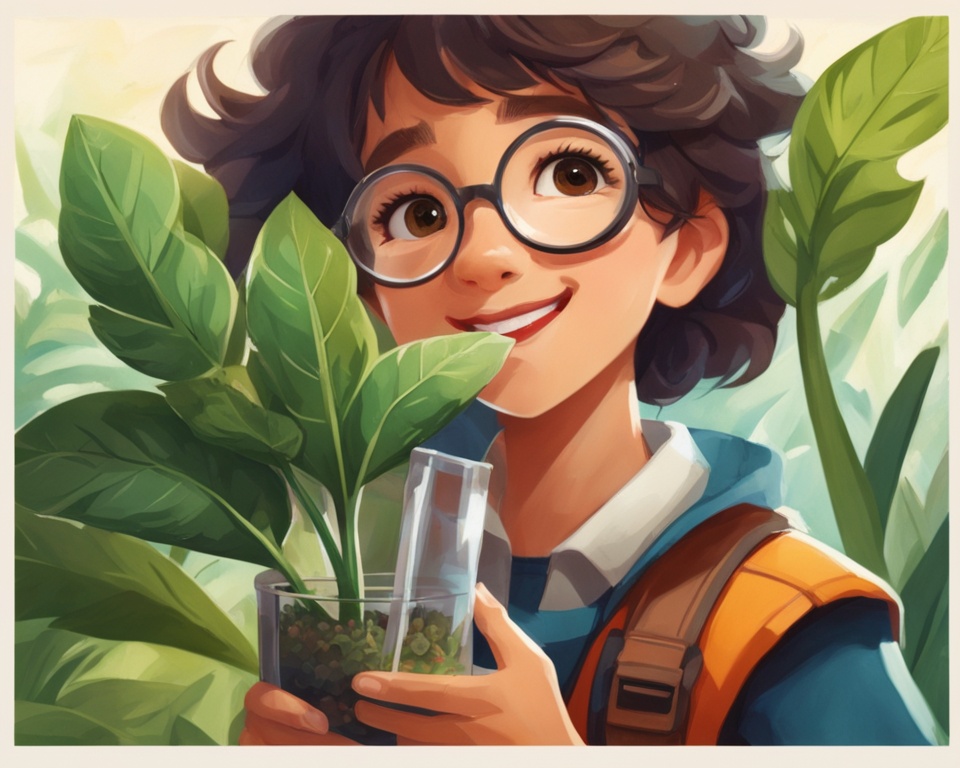The COVID-19 pandemic led to a major shift to remote learning. This change showed us a new side of science education for kids. For instance, Olivia, an 11-year-old, was great at remembering big science words like “homozygous” and “heterozygous.”1 But, as the writer saw, Olivia had a hard time explaining what these words meant. This shows us why we need to do more than just memorize facts in science. We must focus on figuring things out, trying experiments, and learning by doing.
Science is like a big adventure, not just a list of things to memorize.1 We make great future scientists by using new and fun ways to teach and by letting them dig into real science. This helps them really get the point and the beauty of science. It also helps them get better at solving hard problems and thinking carefully. These are skills they need in our modern world, full of cool technology.
Key Takeaways
- Moving beyond rote memorization to focus on the process of scientific discovery, experimentation, and hands-on learning
- Fostering curiosity, creativity, and critical thinking among young learners
- Providing equitable access to high-quality STEM education and mentorship opportunities
- Inspiring the next generation of scientific innovators, particularly young women and underrepresented groups
- Adapting educational approaches to keep pace with technological advancements and emerging career paths
Reigniting the Passion for Scientific Discovery
Through Olivia, the author saw the problem with just memorizing science. Olivia knew complex terms but couldn’t use them well or enjoy science.2 This showed the need to move past just learning from books. Real discovery comes from doing, trying, and being part of science’s journey.
The Importance of Experiential Learning
Looking at Olivia’s interests helped the author teach science better. The key was making science real, not just words on a page.2 This highlighted how doing things in science builds real interest and love for learning.
Fostering Curiosity and Critical Thinking
Olivia showed that we should do more than memorize in science. It’s about asking questions and thinking hard. The author led Olivia to love the process of figuring things out.
Moving Beyond Textbook Memorization
Olivia’s story taught the author that only books aren’t enough in science. Knowing terms isn’t using science.2Learning by doing and thinking is how real scientists grow.
Empowering Future Scientists
The author learned that hands-on learning is key for empowering future scientists. They used real-life experiments to explain scientific ideas to Olivia. This made Olivia take part in finding out more. It used what she already knew and her love to explore.3
Innovative Teaching Methods
The author’s way of teaching focused on doing things rather than just reading books. They got Olivia to check out and test different science stuff. Then Olivia would use what she learned in real situations.4 This made Olivia really understand science and taught her how to solve problems. These are skills she can use in school and work later on.4
Hands-on Learning Experiences
For Olivia, getting to do practical science stuff was very important. The author made experiments that were fun and practical. This made scientific ideas real for Olivia and made her love stem education and science outreach programs.3 It helped Olivia learn more about science. And it made her want to keep on learning about nature.3

The Role of Science Outreach Programs
Olivia’s story underlines how important it is to spark an interest in science early on.5 By supporting her curiosity and using science in her daily life, Olivia got really involved in learning. This shows that science programs are key in reaching all students with STEM education. They make learning about science, technology, engineering, and math more fun and relatable.
Cultivating Scientific Curiosity
Science outreach efforts are key in getting kids interested in science.5 Groups like the Association of Science-Technology Centers, 3M, and Honda focus on getting students excited about science and math. They offer interactive activities that let kids, including Olivia, enjoy and learn from science experiments and critical thinking.
Equitable Access to STEM Education
One big goal of these science outreach programs is to make sure all kids can learn about STEM.5 Efforts like the National Defense Education Program and others aim to offer more college spots and teach about pressing energy and environmental issues. They especially try to help kids who might not usually get these opportunities, making sure science and technology have a bright future.
Thanks to science outreach programs, kids like Olivia can get excited about science, love to learn, and prepare for a future full of possibilities.56
Building a Foundation for Scientific Literacy
The author’s interaction with Olivia shows the importance of starting with a strong science literacy base early. By involving Olivia in practical and engaging learning experiences, the author helped her see how science is part of daily life. This teaching method helped Olivia really understand and value science.
Such an approach is key for science education. It helps in developing not only knowledge but also critical thinking and problem-solving skills. These are important in today’s complex, technology-filled world.
Olivia learned more than just facts through these hands-on experiences. She grasped the basic principles of science. This approach sparked her scientific curiosity. It also gave her the foundation to be an active participant in scientific exploration.
Nurturing her love for learning, the author motivated Olivia to consider STEM careers. Olivia might become part of the next scientific advances, thanks to this inspiration.
Supporting high-quality youth mentorship that focuses on hands-on learning is essential. Such programs are vital for laying a solid science literacy foundation for the young.7 They help students love science and develop critical thinking skills. This prepares them to contribute to science in the future.

Inspiring the Next Generation of Innovators
The author learned a lot from working with Olivia. They found it’s key to inspire future scientists, especially girls, in the STEM fields. Giving Olivia practical learning opportunities really sparked her interest in science.
This method highlights the importance of mentorship and making STEM inclusive. It helps young people from all backgrounds dream of becoming scientific leaders.8
Fostering Innovative Thinking
Working with Olivia taught the author a big lesson: we need to encourage new ways of thinking to make great scientists. Instead of just memorizing facts, the author showed Olivia how to think like a scientist.
This approach makes science fun and teaches skills like critical thinking. These are really important in our high-tech world.
Companies like Illumina are big supporters. They celebrate DNA Day every April. Plus, they offer cool learning initiatives for students of all ages.8 Their work with “I Am a Scientist” and the Spark Kits shows they’re serious about inspiring the next science stars.
Viasat is also doing its part, focusing on global communication. They hold events like the ‘Viasat Beyond: Space’ challenge and Space Camps. This helps spread STEM education to kids who might not have many opportunities.9
These unique education methods are crucial for our future. By using them, we’re setting the stage for a world filled with bright thinkers and problem solvers.
Reimagining Educational Spaces for Effective Learning
The need to change how we learn is clear from the story of the author’s friend, Olivia. Her journey shows we should mix subjects with what students already like to make learning fun and more useful. This makes learning stick and not just something to forget after a test. Letting each student learn in their way helps a lot.
Agile Curriculum for Personalized Learning
Today, the old way of teaching everyone the same just doesn’t work. The world wants new grads to have special skills.10 So, schools and colleges must change to meet these new demands. Giving each student a unique path that matches their dreams helps them succeed.
Integrating Technology and Arts Education
Mixing tech and arts in school is crucial for teaching kids about today’s world. With AI and new tech everywhere, students must learn to think and solve problems creatively.11 Combining science with arts helps kids be ready to tackle the big issues the world faces.

Good learning happens when the setting is flexible and focused on the student. This kind of approach brings out the best in every learner. It uses new tech and arts to make learning exciting. This way, educators help children to grow into bright minds and problem-solvers of the future.
Collaborating for Scientific Advancement
Science education involves many people working together over time. It uses the discoveries of past researchers. This makes it a global effort. It helps future scientists connect worldwide while expanding our knowledge.12
Connecting Students Globally
Science outreach programs let students from different countries interact. They share thoughts, research, and work on projects together. This process reveals diverse perspectives and boosts cultural understanding in science. It leads to big advancements that help everyone.1314
Building on Past Discoveries
It’s vital to stress building on what past scientists have done. Learning about the history of science helps students see the journey of ideas. They learn that advancements in science are not always straightforward. Rather, they are the result of constant exploration and new discoveries.1214
Encouraging global teamwork and honoring past knowledge will prepare the next innovators. They will face global challenges head-on. By working together, their efforts will further advance science and technology.1314
Overcoming Barriers to STEM Education
The story of Olivia clearly shows why we need to break down the barriers to STEM education. This is especially true for those in underserved areas. Women still face challenges in STEM fields, keeping their numbers low.15 Including women in science and tech is crucial. It adds unique perspectives and boosts progress.15 However, many women leave STEM careers due to discrimination and lack of support.15 Solving the gender gap in STEM means we must start early and keep going.
Addressing Funding Challenges
16 Developing countries often lack the funds and structure for STEM education. The shortage of good STEM teachers affects education quality, especially in these places.16 Getting everyone, despite their gender or wealth, equal chances in STEM education is hard too.16 Also, students here miss out on practical learning, which is a big issue in STEM education.
Breaking Stereotypes and Promoting Inclusivity
The writer’s approach with Olivia linked science to her life, spiking her interest. This shows how making STEM education relatable is key to sparking curiosity.15 Adding women’s perspective in science and tech boosts innovation and growth.15 Tackling STEM gender gaps needs a full-from the base to the top approach.

Measuring Success in Science Education
Science education is always changing. So, how we measure its success should change too. Stem education, measuring success, assessing critical thinking, and tracking long-term outcomes have become very important. They help us make sure students are getting the most out of their science lessons.12
Assessing Critical Thinking Skills
Traditional tests can fall short in showing how well science education is working. The story of Olivia shows us this. By looking at how Olivia uses science in everyday life, we learned a lot about her critical thinking. This way, we saw she really understands how science works.12 It tells us we need to use more than just tests. We need ways to see if students can solve problems, be creative, and think like scientists.
Tracking Long-Term Outcomes
It’s not just about what students do in a test today. We must see the long-lasting effects of science education. Research before college, for example, can make students more interested in STEM areas. It can make them like STEM more and stay in these fields through college.12 When students work on real projects, their understanding of science grows. This also helps them see themselves as scientists.
Having a mentor is key to success in student research. Mentors help a lot by giving support and showing students new things. This often makes students stay interested in STEM areas for longer.12 Still, we don’t know enough about what mentors think and how they teach. We need to learn more about the teacher-student relationship in research.
Taking a bigger view in how we measure success can improve science education. We need to focus not just on tests but on how well students can think critically and solve problems. This way, we can really help the next group of scientists and creators.

The Future of Science Education
The world is changing fast because of new technologies. So, science education must change too. This is to make sure students are ready for the jobs and issues of the future.17 Teaching, as with Olivia, needs to use hands-on and tech-based methods. These help students really understand science and use it in real life.
Adapting to Technological Advancements
Teachers can use new technologies to create exciting learning spaces. These spaces get students like Olivia interested and ready for a tech-focused future.17 Things like virtual experiments, augmented reality, and data tools make science come alive. Students can now interact and understand complex ideas like never before.
Preparing Students for Emerging Careers
Jobs are changing, becoming more tech-focused. It’s key that science classes prepare students for these new opportunities.17 Adding subjects like coding, robotics, and data science to the curricula does this. It equips students with the skills they’ll need in a changing world. They can help drive future tech advancements.
The future of science teaching should be forward-looking. It should take full advantage of new tech and ways of learning to inspire the next group of scientists and thinkers.17 By adjusting to meet the challenges of our fast-changing world and ensuring everyone gets top-notch STEM education, we build a future based on strong science understanding, creative thinking, and smart problem-solving. This paves the way for a fair, sustainable, and prosperous future.
Conclusion
This article has shown how important it is to redesign science education. Doing so will help future scientists and innovators. We need to move past just memorizing facts and reading from books.
We should provide chances for students to learn through doing. This includes using their hands and minds to explore and understand science better. Such an approach can inspire young people to become problem-solvers and creators.
Offering learning that is guided by mentors is also crucial. It should use real-world examples and the latest technology. This way, students will gain the knowledge and attitude to face a world that’s more complex every day.
To make science accessible to everyone, we must tackle financial issues and do away with old views. It’s vital to make sure science welcomes all, no matter their background. This can open up life-changing education for many.4
Looking forward, inspiring the next wave of scientists and thinkers is key to our society’s growth. A complete focus on the student can unleash tremendous potential. It also prepares us for a tomorrow that’s both prosperous and sustainable.12144
FAQ
What is the importance of moving beyond rote memorization in science education?
How can hands-on, experiential learning foster a deeper understanding of scientific concepts?
What is the role of science outreach programs in making STEM education accessible and engaging for all students?
How can mentorship and inclusive educational practices empower young people, especially girls and underrepresented groups, to pursue STEM careers?
What are the benefits of adopting an agile, personalized curriculum in science education?
How can inclusive and equitable educational practices address the barriers to high-quality STEM education?
What are the limitations of traditional, test-based assessments in evaluating the success of science education?
How can science education adapt to the rapid technological advancements shaping our world?
Source Links
- https://www.ncbi.nlm.nih.gov/pmc/articles/PMC9330198/
- https://www.nyas.org/wp-content/uploads/2024/04/NYAS-Corporate-Brochure.pdf
- https://www.nordangliaeducation.com/biss-puxi/news/2024/03/empowering-future-scientists
- https://www.donorschoose.org/project/empowering-future-scientists-enhancing/8417054/
- https://www.asbmb.org/education/science-outreach/outreach-resources
- https://cerncourier.com/a/empowering-children-to-aspire-to-science/
- https://www.hudsonalpha.org/unlocking-the-power-of-science-literacy-a-path-to-a-brighter-future/
- https://www.illumina.com/company/about-us/corporate-social-responsibility/empower-communities/stem-education.html
- https://news.viasat.com/blog/corporate/how-viasat-is-empowering-the-next-generation-of-stem-innovators
- https://www.aacu.org/liberaleducation/articles/reimagining-stem-education
- https://onlinelearningconsortium.org/reimagining-learning-and-empowering-outcomes-with-ai/
- https://www.biorxiv.org/content/10.1101/2024.03.15.585231v1.full
- https://www.nsf.gov/awardsearch/showAward?AWD_ID=2153259&HistoricalAwards=false
- https://medium.com/mostly-about-science-mas/empowering-future-scientists-the-power-of-great-lab-supervision-e65623fba83e
- https://englishpluspodcast.com/empowering-women-in-stem-breaking-barriers-and-shaping-the-future/
- https://steamspirations.com/the-future-of-stem-education-in-developing-countries-empowering-innovators-and-building-bright-futures/
- https://www.thedeeping.eu/2024/05/10/empowering-communities-through-science-education/
